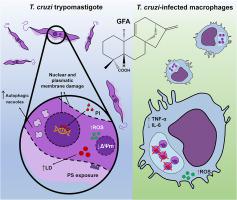Toxicology in Vitro ( IF 2.6 ) Pub Date : 2021-10-22 , DOI: 10.1016/j.tiv.2021.105267 Manoela Daiele Gonçalves 1 , Bruna Taciane da Silva Bortoleti 2 , Fernanda Tomiotto-Pellissier 2 , Virginia Marcia Concato 3 , Ricardo Luís Nascimento de Matos 1 , Taylon Felipe Silva 3 , Ana Carolina Jacob Rodrigues 2 , Amanda Cristina Machado Carloto 3 , Idessania Nazareth Costa 3 , Danielle Lazarin-Bidóia 3 , Milena Menegazzo Miranda-Sapla 3 , Wander Rogério Pavanelli 3 , Nilton Syogo Arakawa 1 , Ivete Conchon-Costa 3

|
Grandiflorenic acid (GFA) is one of the main kaurane diterpenes found in different parts of Sphagneticola trilobata. It has several biological activities, especially antiprotozoal action. In turn, Chagas disease is a complex systemic disease caused by the protozoan Trypanosoma cruzi, and the drugs available to treat it involve significant side effects and impose an urgent need to search for therapeutic alternatives. In this context, our goal was to determine the effect of GFA on trypomastigote and intracellular amastigote forms. Our results showed that GFA treatment led to significantly less viability of trypomastigote forms, with morphological and ultrastructural changes in the parasites treated with IC50 of GFA (24.60 nM), and larger levels of reactive oxygen species (ROS), mitochondrial depolarization, lipid droplets accumulation, presence of autophagic vacuoles, phosphatidylserine exposure, and plasma membrane damage. In addition, the GFA treatment was able to reduce the percentage of infected cells and the number of amastigotes per macrophage (J774A.1) without showing cytotoxicity in mammalian cell lines (J774A.1, LLCMK2, THP-1, AMJ2-C11), in addition to increasing TNF-α and reducing IL-6 levels in infected macrophages. In conclusion, the GFA treatment exerted influence on trypomastigote forms through an apoptosis-like mechanism and by eliminating intracellular parasites via TNF-α/ROS pathway, without generating cellular cytotoxicity.
中文翻译:

从 Sphagneticola trilobata 中分离出的 Grandiflorenic acid 对克氏锥虫:毒性、作用机制和免疫调节
Grandiflorenic acid (GFA) 是在三叶草不同部位发现的主要贝壳杉二萜之一。它具有多种生物活性,尤其是抗原生动物作用。反过来,南美锥虫病是由原生动物克氏锥虫引起的一种复杂的全身性疾病,可用于治疗它的药物具有显着的副作用,因此迫切需要寻找治疗替代品。在这种情况下,我们的目标是确定 GFA 对锥体和细胞内无鞭毛体形式的影响。我们的研究结果表明,GFA 处理显着降低了锥鞭毛体形式的活力,用 IC 50处理的寄生虫的形态和超微结构发生了变化GFA (24.60 nM) 和更高水平的活性氧 (ROS)、线粒体去极化、脂滴积累、自噬泡的存在、磷脂酰丝氨酸暴露和质膜损伤。此外,GFA 处理能够降低感染细胞的百分比和每个巨噬细胞 (J774A.1) 的无鞭毛体数量,而不会在哺乳动物细胞系中显示细胞毒性 (J774A.1、LLMK 2、THP-1、AMJ2-C11) ,除了增加 TNF-α 和降低感染巨噬细胞中的 IL-6 水平。总之,GFA 处理通过细胞凋亡样机制和通过TNF-α/ROS 途径消除细胞内寄生虫对锥鞭毛体形式产生影响,而不会产生细胞毒性。































 京公网安备 11010802027423号
京公网安备 11010802027423号